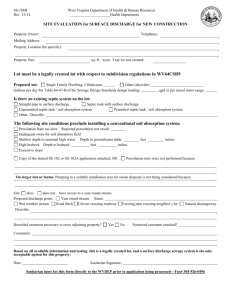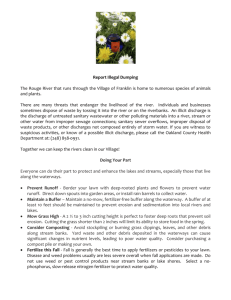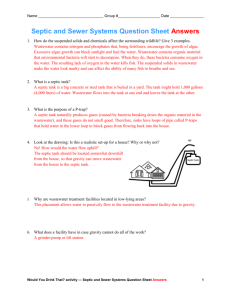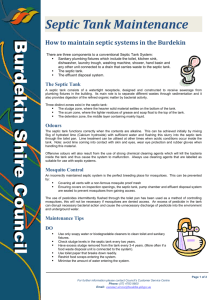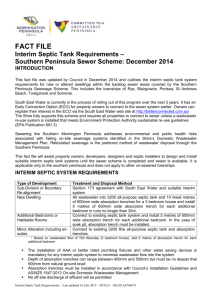ENVIRONMENTAL HEALTH SERVICES
advertisement
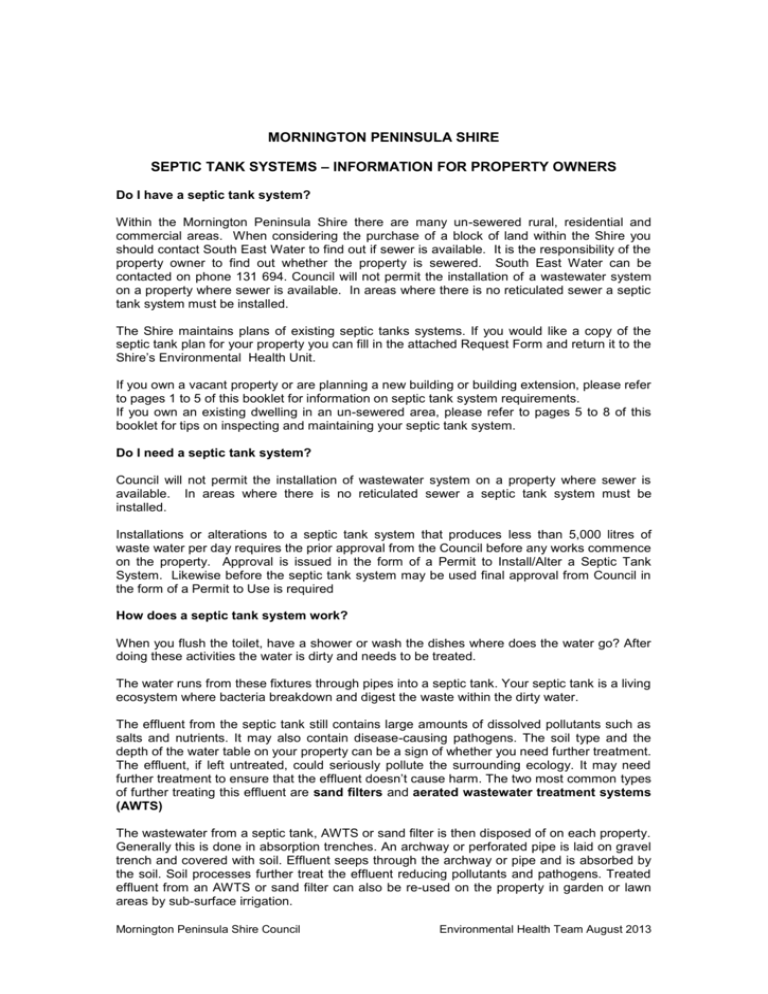
MORNINGTON PENINSULA SHIRE SEPTIC TANK SYSTEMS – INFORMATION FOR PROPERTY OWNERS Do I have a septic tank system? Within the Mornington Peninsula Shire there are many un-sewered rural, residential and commercial areas. When considering the purchase of a block of land within the Shire you should contact South East Water to find out if sewer is available. It is the responsibility of the property owner to find out whether the property is sewered. South East Water can be contacted on phone 131 694. Council will not permit the installation of a wastewater system on a property where sewer is available. In areas where there is no reticulated sewer a septic tank system must be installed. The Shire maintains plans of existing septic tanks systems. If you would like a copy of the septic tank plan for your property you can fill in the attached Request Form and return it to the Shire’s Environmental Health Unit. If you own a vacant property or are planning a new building or building extension, please refer to pages 1 to 5 of this booklet for information on septic tank system requirements. If you own an existing dwelling in an un-sewered area, please refer to pages 5 to 8 of this booklet for tips on inspecting and maintaining your septic tank system. Do I need a septic tank system? Council will not permit the installation of wastewater system on a property where sewer is available. In areas where there is no reticulated sewer a septic tank system must be installed. Installations or alterations to a septic tank system that produces less than 5,000 litres of waste water per day requires the prior approval from the Council before any works commence on the property. Approval is issued in the form of a Permit to Install/Alter a Septic Tank System. Likewise before the septic tank system may be used final approval from Council in the form of a Permit to Use is required How does a septic tank system work? When you flush the toilet, have a shower or wash the dishes where does the water go? After doing these activities the water is dirty and needs to be treated. The water runs from these fixtures through pipes into a septic tank. Your septic tank is a living ecosystem where bacteria breakdown and digest the waste within the dirty water. The effluent from the septic tank still contains large amounts of dissolved pollutants such as salts and nutrients. It may also contain disease-causing pathogens. The soil type and the depth of the water table on your property can be a sign of whether you need further treatment. The effluent, if left untreated, could seriously pollute the surrounding ecology. It may need further treatment to ensure that the effluent doesn’t cause harm. The two most common types of further treating this effluent are sand filters and aerated wastewater treatment systems (AWTS) The wastewater from a septic tank, AWTS or sand filter is then disposed of on each property. Generally this is done in absorption trenches. An archway or perforated pipe is laid on gravel trench and covered with soil. Effluent seeps through the archway or pipe and is absorbed by the soil. Soil processes further treat the effluent reducing pollutants and pathogens. Treated effluent from an AWTS or sand filter can also be re-used on the property in garden or lawn areas by sub-surface irrigation. Mornington Peninsula Shire Council Environmental Health Team August 2013 What types of septic tank systems are available? Your septic tank system must be designed and installed in accordance with requirements of the Environment Protection Act 1970, State Environment Protection Policies, Septic Tanks Code of Practice March 2003, Australian Standards and other relevant publications. Council will only allow the installation of a septic tank system that has been approved by the Environment Protection Authority (EPA). A list of EPA approved systems is available from www.epa.vic.gov.au/ For Local Government/List of Approved Wastewater Treatment Systems. Do I need a Land Capability Assessment? A land capability assessment (LCA) or soil percolation test does not have to be attached to your septic tank application. The Shire may request a LCA if further information is needed on the type of soil at your property. If a soil test has already been completed for your property indicating soil profile to a depth of 1.5 metres (e.g. a building footing test) it is a good idea to include a copy of this test with your septic tank application. Which type of system is best for my property? The suitable types of septic system for a property depend on the soil type and other site conditions. Based on indicative soil conditions the approved systems in each township are shown below: Catchments Towns Ballar Creek Mount Eliza, Mornington, Mount Martha, Moorooduc, Tuerong, Tyabb, Somerville, Baxter, Pearcedale, Hastings, Bittern, Crib Point, Somers, Kackeraboite Creek Mornington Dromana Hastings Somerville Flinders Main Ridge, Flinders, Cape Schanck Portsea Tootgarook, Fingal, Rye, St Andrews Beach, Blairgowrie, Sorrento, Portsea Red Hill Balnarring, Merricks North, Red Hill, Shoreham, Red Hill South, Merricks, Point Leo, Merricks Beach, Balnarring Beach Mornington Peninsula Shire Council Permitted Treatment Systems Septic Tank Sand Filter Aerated Wastewater Treatment System (AWTS) Worm Farm Biofilters Refer EPA web page for other systems Permitted Disposal Systems* Absorption Trenches Absorption-Transpiration Trenches Sub-surface irrigation Surface irrigation Reed Beds Niimi trenches (grey water only) Refer EPA web page for other systems As above Septic tank and worm farm not permitted in Cape Schanck As above Absorption trenches and absorption/transpiration trenches not permitted in Cape Schanck AWTS Sub-surface irrigation Re-circulating sand filters Refer to the Interim Septic System Fact File Septic Tank Sand Filter Aerated Wastewater Treatment System Worm Farm Refer EPA web page for other systems Absorption Trenches Absorption-Transpiration Trenches Sub-surface irrigation Surface irrigation Niimi trenches (grey water only) Refer EPA web page for other systems Environmental Health Team August 2013 Rosebud Arthurs Seat, McCrae, Rosebud, Boneo, Rosebud West As above As above Septic tank or worm farm not approved in Boneo and Rosebud West Absorption trenches and absorption/transpiration trenches not permitted in Boneo and Rosebud West * Installed in accordance with AS/NZ 1547:2000 On-site Domestic Wastewater Management How do I apply to install a septic tank system? A. Decide on the septic tank system for your property. You should consult a septic tank system installer when deciding on the best system for your property. You can also contact the Shire’s Environmental Health section for advice. B. Decide on the applicant for the application form and sign the authorisation form on page 1 of the form and attach the application fee. C. The applicant should fill out the form using the following checklist – ڤComplete pages 1,3 and 4 for permit to alter or pages 1,2 and 4 for permit to install ڤOwner has completed and signed authorisation on page 1 ڤList the number of persons using the system, plumbing fixtures and size of tank ڤList type of sewage treatment plant and method of effluent disposal ڤAttach copy of any land capability assessment or soil percolation test conducted for the site ڤAttach a scaled (1:200) site plan including floor plan of the dwelling showing all rooms and plumbing fixtures ڤAttach a scaled (1:200) locality plan showing the location of the dwelling, septic tank system, site features such as buildings, driveways and watertanks, and site contour lines ڤApplicant has signed and dated the application form on page 4 ڤApplication fee is attached to the form ڤEnsure site is clearly marked with a street number A permit is required from the Shire to install a new septic tank system or to alter an existing septic tank system. A permit to alter is required if – A. The disposal system (soak pits, absorption trenches or irrigation area) is being relocated or upgraded OR B. The septic tank or sewage treatment plant is being relocated or upgraded OR C. Additional plumbing fixtures are being added to the septic tank system OR D. Bedrooms are being added to the dwelling that will increase the daily wastewater flow to the system OR E. The existing septic tank system is malfunctioning and is being repaired or replaced OR F. The internal plumbing is being altered but there is no additional wastewater load on the system and there is no alteration to the septic tank or effluent disposal system. This is known as a minor alteration and incurs a lesser fee. The existing system must comply with current requirements and soak pits or split systems must be upgraded with a full alteration fee. Prior to commencing any works on your septic tank system a Permit to Install/Alter must be issued by the Shire. Applications that have been correctly completed will be assessed within 15 working days of receipt. The Environmental Health Officer will conduct a site inspection to assess the application, and if further information is required a letter will be sent to the applicant. If the officer determines that the application is satisfactory a permit to install/alter will be issued to the applicant and the owner. Where can my septic system be installed? Your septic system should be installed in the area nominated on your approved septic tank plan. If it is going to be located in a different area, the installer should get permission from the Shire before installing the system. The installer should also draw a plan of where the system has been installed, and a copy of this plan should be sent to the Shire. Mornington Peninsula Shire Council Environmental Health Team August 2013 The septic system should be located at certain distances from boundaries, buildings, and waterways. These are called setback distances and are attached to this booklet. Septic tanks and disposal systems should be located in garden, lawn, and vegetated areas and be kept clear of: Vehicles, driveways and car parks Paved, sealed or gravel surfaces Areas subject to long periods of shade, inundation or stormwater run-off Stormwater systems Underground service pipes for gas, electricity, phone, water and drainage Swimming pools Tennis courts Buildings, decking, garages and carports Livestock Fruit and vegetables for human consumption The septic disposal system should be located level along the contour of land and in areas with a slope of less than 20%. Who inspects my septic tank system? A Shire Environmental Health Officer will inspect the system during installation to ensure that it has been installed correctly and complies with the Septic Tanks Code of Practice. Shire officers will also be conducting random inspections of septic tank systems each year as part of the Shire’s Domestic Wastewater Management Plan. When can I use the septic tank system? The permit to install does not allow the septic tank system to be used. The system can only be used when the Shire is satisfied that the system has been installed correctly and issues a Permit to Use the system. To check whether the system has been installed correctly, Council requires the following information: 1. Inspection of the system by an Environmental Health Officer during installation of the disposal trenches or sub-surface irrigation system. During this inspection the Shire will check whether the conditions in the permit to install have been complied with. If the system was not inspected during installation a Shire Environmental Health Officer must conducted a final inspection of the system before issuing a permit to use. 2. Copies of the plumbing compliance certificate for the sanitary plumbing, below ground sewer and septic tank installation works. 3. An as constructed plan of the septic tank system showing the location of the septic tank, sewage treatment plant and disposal trenches/irrigation area. 4. If a mechanical treatment plant has been installed, a copy of the commissioning report from the accredited treatment plant service agent If any of this information has not been received the Shire is unable to issue a permit to use the septic tank system. It is the responsibility of property owners to ensure that this information is submitted to the Shire. How do I maintain my septic tank system? Your septic may need attention if any of these conditions occur: A rotten egg smell is noticed around your septic system. There is prolific green grass around your absorption trenches or discharge pipe. The ground is damp or soggy around absorption trenches. The toilet or drains are slow to clear.. The septic has not been checked in over 12 months. The septic has not been desludged in 3 years Mornington Peninsula Shire Council Environmental Health Team August 2013 WHAT ARE COMMON CAUSES OF SEPTIC SYSTEM PROBLEMS? The tank contains too much scum and sludge Solid scum and sludge form at the top and the bottom of the tank as the effluent passes through. The solids don’t move from the tank. It just begins to build up. This is the reason the tank needs to be pumped regularly. If the tank doesn’t get pumped out wastewater with solids will flow out of the tank untreated. This will cause problems with your absorption trenches, pumps, sand filters, or if you have an offsite discharge flow untreated effluent into our waterways. Garbage disposal units add considerably to the amount of solids entering your system Solution: Desludge your system every 3 years, more frequently if there is heavier usage. Newly pumped out septic tanks should be filled with water and a handful of lime added to prevent odours. If a garbage disposal unit is installed regular desludging is imperative Overloading the system with water Too much water causes the wastewater to flow too quickly through the tank before the bacteria have a chance to break it down. This can result in clogging of absorption trenches due to solids being pushed through the system. This is common in holiday homes, where the system is not used for most of the year and then overloaded during the peak holiday season Solution: Use less water. Tank too full If you have a septic tank and absorption trench the level in the tank should not be higher than the outlet. If you have a pump out system, the pump should be no more than 2/3 full. Failure of the pump will cause odours and eventually breakdown of absorption system. Solution: If level of tank is higher than the outlet get your system pumped. If pump has broken down immediate repair or replacement is essential Protect the septic drainage field Flooded drain fields are not only smelly messy nuisances but can spread diseases and contaminate drinking water. Building structures, planting trees, parking vehicles or allowing animals to graze can cause detriment to your absorption trench. Do not cover absorption trench with concrete or pavers or let children play on absorption trenches. Solution: Don’t water the garden or wash the car near the absorption trench. Small shrubs and plants may be grown over the absorption or sand filter area. Root systems from large trees can crack pipes and should be avoided. The following are suitable for growing over absorption trenches: CANNAS JAPANESE ANEMONES N.Z. FLAX SPRENGELIA KALMIA ANGUSTIFOLIA JAPANESE IRISES Mornington Peninsula Shire Council HELENIUMS HOSTA ZENOBIA BAURA SESSILIFLORA LEYCESTERIA DWARF SALVIA BONFIRE SALVIA HEMBROCALLIS MELALUCA GIBBOSA Environmental Health Team August 2013 . Toxic chemicals going into system Chemicals like paints, solvents, oils, disinfectants, pesticides etc can kill the helpful bacteria in your septic system. The bacteria help breakdown the effluent. The loss of bacteria stops it digesting effluent. Solution: Switch to bio-degradable or natural cleaners if possible, and use smaller amounts. Bicarbonate of soda and vinegar are good alternatives. MAINTENANCE Attention to the care and maintenance of your septic system can prevent problems and save the cost of repair and early replacement. At least once a year, inspection covers over your septic tank should be removed to determine the depth of the scum and sludge. Tanks should not be washed or disinfected after the sludge and the scum has been pumped out, but simply refilled with water to reduce odours on start up. A small amount of sludge should be left in the tank to re-establish bacterial action. A final point concerns the frequency of de-sludging. It is important to have the sludge depth checked at least annually. Many homeowners may be reluctant to perform this operation. It may be best carried out by a contractor. Generally a septic tank should be de-sludged every 3 years if used regularly. FOR FURTHER ADVICE PLEASE CONTACT EPA: (03) 9794 0677 or at www.epa.vic.gov.au The Mornington Peninsula Shire: (03) 5986 0969 Your local drainer: look in yellow pages under Drainers Septic tank specialists: look in yellow pages under Septic Tank Contractor Mornington Peninsula Shire Council Environmental Health Team August 2013 Mornington Peninsula Shire Council Environmental Health Team August 2013
